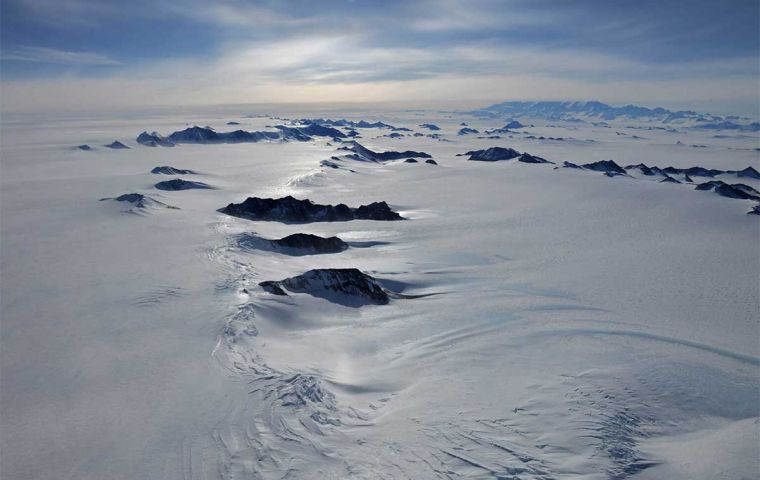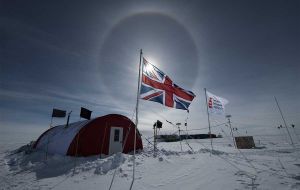MercoPress. South Atlantic News Agency
Scientists discover micro plastics in Antarctica deep field camps
 A view over the Ellsworth Mountains, West Antarctica. Credit: Steve Gibbs, BAS
A view over the Ellsworth Mountains, West Antarctica. Credit: Steve Gibbs, BAS Scientists have discovered microplastics in the snow near some of Antarctica’s deep field camps, revealing how far-reaching plastic pollution has become. While not new, it’s the first time these tiny pieces of plastic have been found in remote locations.
The study was conducted at field camps, at Union Glacier and Schanz Glacier (near the Ellsworth Mountains), where researchers were carrying out field work, and the South Pole where the US Antarctic Program has a research station. It is first time a new and advanced technique has been used to detect microplastics as small as 11 micro meters (about the size of a red blood cell) in the snow in Antarctica. The study is published this week (6 February 2025) in the journal Science of the Total Environment.
The findings surprised the team as microplastics were found at concentrations ranging from 73 to 3,099 particles per liter of snow. Most of these particles (95%) were smaller than 50 micrometers (0.005 cm, the size of most human cells), suggesting previous studies may have underestimated the extent of microplastic pollution in the region due to less sensitive detection methods.
Previous methods involved hand-picking particles and fibers out of samples for laboratory analyses. However, the newer technique involves melting snow through filter paper and scanning this at a high resolution, using infrared spectroscopy, so any plastics above 11 micrometres can be identified.
Dr Emily Rowlands, a marine ecologist at British Antarctic Survey (BAS) and co-author of the paper says: “With these developing techniques, we’re now able to analyze microplastics of a much smaller size than before. In fact, we found microplastic abundance in these snow samples to be 100 times higher than in previous studies of Antarctic snow samples.”
Across the three sites where the researchers collected snow samples, they identified common plastic types such as polyamide (used in textiles), polyethylene terephthalate (found in bottles and packaging), polyethylene and synthetic rubber. While polyamide accounted for over half of the microplastics the researchers found and was discovered in all the samples taken close to field camps but, interestingly, not at the remote ‘control’ site.
Dr Clara Manno, an ocean ecologist at British Antarctic Survey, adds: “We think this means that there are local sources of plastic pollution, at least when it comes to polyamide. This could come from outdoor clothing, or the ropes and flags that are used to mark safe routes in and around the camp.
“We need to do more research to fully understand the sources of microplastic pollution in Antarctica – how much of it is local, and how much is transported over long distances so we can explore how best to reduce this plastic pollution in one of the most pristine places on Earth.”
The broader implications of microplastics in this frozen wilderness are not yet fully understood. Some research suggests that microplastics could affect the snow’s albedo (how much light it reflects) and how quickly it melts. It can also be transported to areas of ecological importance. Microplastics have already been detected in several penguin, seal and fish species, and one recent BAS study revealed that microplastics could also be reducing the amount of carbon that is transported to the seafloor by tiny shrimp-like creatures called krill.
Dr Kirstie Jones-Williams, who carried out the fieldwork at the remote field camps and is co-author of the paper says: “Despite stringent regulations on materials entering Antarctica, our findings reveal microplastic contamination even in remote and highly controlled areas. This underscores the pervasive nature of plastic pollution—demonstrating that nowhere on Earth is truly untouched. Our research highlights the need to leverage existing Antarctic presence for sustained monitoring. As the world seeks accountability through the United Nations Environment Assembly Global Plastics Treaty, regular assessments in such pristine environments could provide critical evidence for policy and action”.
This research highlights the stark reality that even the most untouched corners of the planet are not free from human impact. The presence of microplastics in Antarctic snow highlights the importance of studying these remote environments to understand the global spread of plastic pollution over time. (Source BAS)
(*) Microplastics in Antarctica – A plastic legacy in the Antarctic snow? by Jones-Williams, K., Rowlands, E., et al is published today in Science of the Total Environment.





Top Comments
Disclaimer & comment rulesCommenting for this story is now closed.
If you have a Facebook account, become a fan and comment on our Facebook Page!